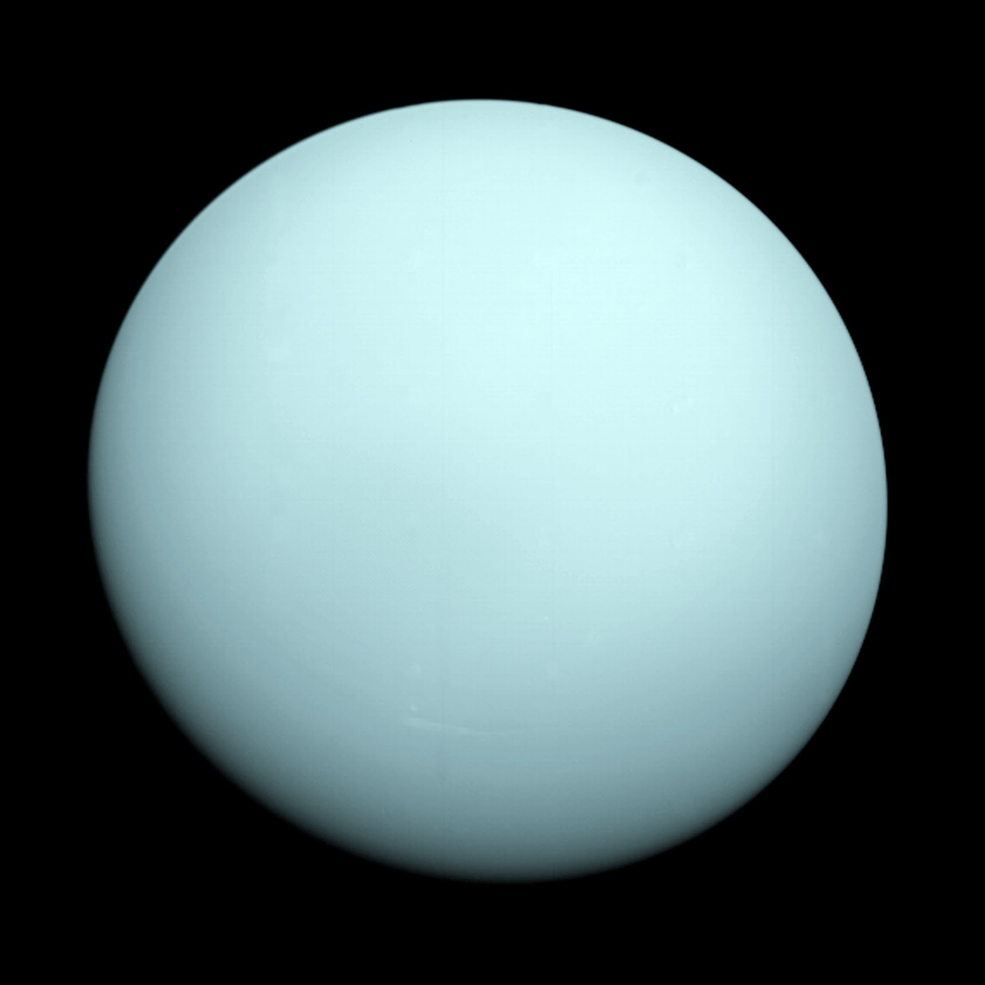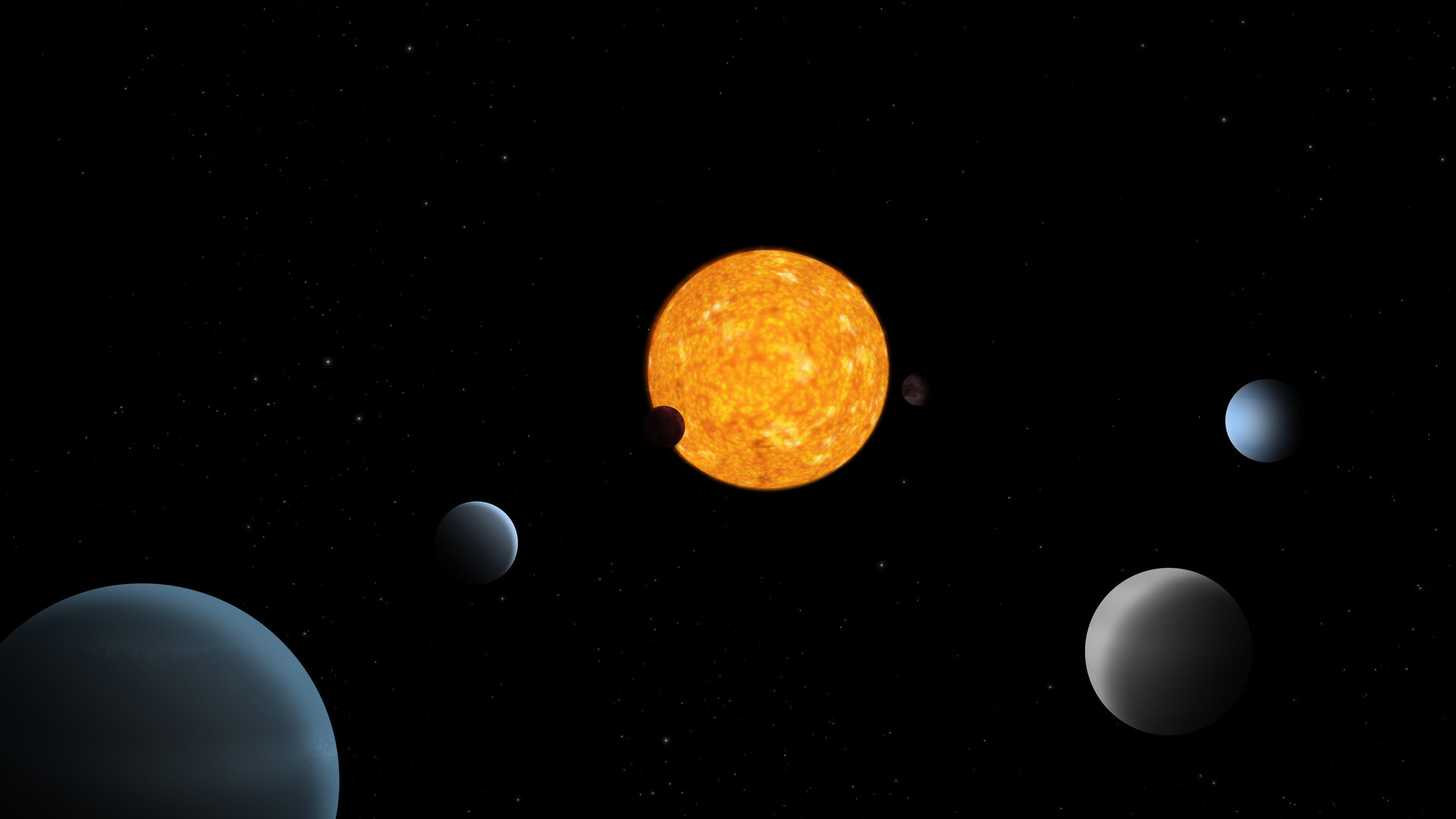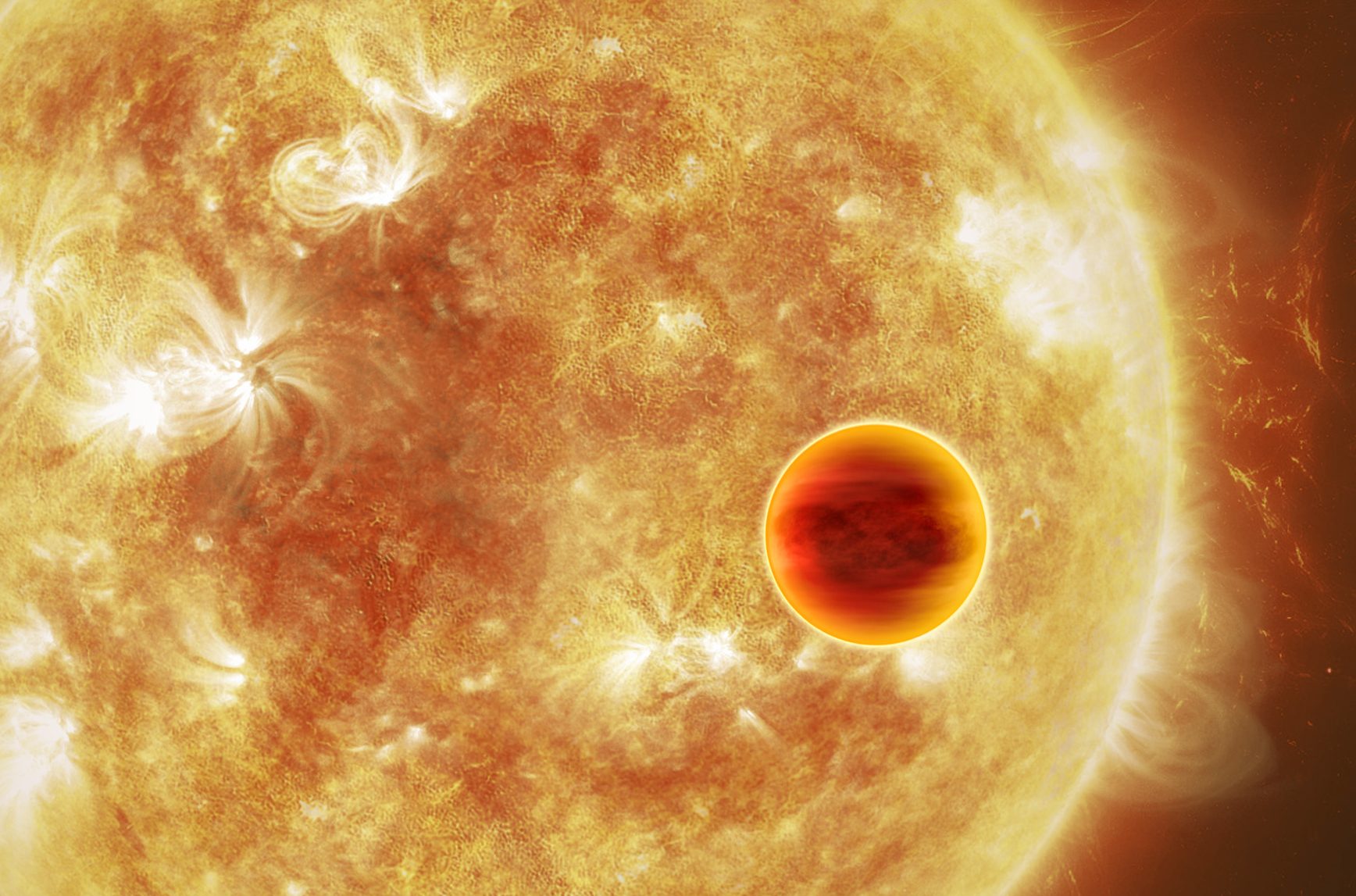Saturn’s rings finally explained after more than 400 years

- Observed since the invention of the telescope back in 1609, Saturn’s rings were a wholly unique feature within our Solar System.
- While the other giant planets have since been discovered to have rings, they’re faint and unimpressive compared to Saturn’s.
- Despite all we’ve learned about our Solar System, the origin of Saturn’s rings have remained an unsolved puzzle. Perhaps, that is, until now.
Of all the planets visible in the night sky, either with the naked eye or the aid of a powerful telescope, none is more recognizable or iconic than Saturn. With its giant system of rings, Saturn’s appearance is immediately discernible, setting it apart from all the other known planets. First observed as “ears” by Galileo in 1609, a sharper view reveals that Saturn doesn’t have a shape like an amphibian’s eyes, but rather an expansive set of rings, detached and separated from the planet it surrounds. Over time, gaps, moons, moonlets, and a plethora of other features have been found above, below, inside, outside, and even within Saturn’s rings.
None of the rocky planets, asteroids, or Kuiper belt objects have rings. Jupiter, Uranus, and Neptune possess them, but they’re all much fainter, sparser, smaller, and less massive than Saturn’s. In addition, Saturn’s rings are tilted, are made almost exclusively of water-ice, and are in the process of evaporating. Once thought to have been a mainstay of the Solar System, we now believe that Saturn’s rings formed in the cosmic blink of an eye approximately 100 million years ago, and should be gone within less than another 100 million.
How did Saturn’s rings form? Despite a number of proposals, no one solution has emerged as a clear front-runner. Until, that is, a new study led by MIT’s Jack Wisdom was published in Science on September 15, 2022. A single violent event, just 150 million years ago, could explain not only Saturn’s rings, but a series of bizarre properties found only in the Saturnian system. Here’s the science behind this wild but promising new idea.

Whenever a giant planet — particularly one like Jupiter or Saturn — forms in a stellar system like our own, we can expect a number of steps to occur. From an initial, central protostar with a protoplanetary disk surrounding it,
- rock-and-metal cores will develop around large, growing instabilities within the disk,
- those cores will begin attracting surrounding material and growing rapidly,
- and upon reaching a critical size, will begin hanging onto volatile compounds and elements,
- forming gas giant worlds with circumplanetary disks around them,
- where those disks will rapidly develop instabilities and form moons of varying sizes and compositions,
- with volatiles existing in the solid, liquid, and/or gas phases depending on the temperatures of those moons and their distance from the parent star.
However, Jupiter and Saturn have some remarkable differences between them: more striking than their differing masses, sizes, colors, and compositions. Although they rotate with similar periods (9.9 hours to 10.5 hours), Saturn has a much greater axial tilt: 26.73° to 3.13°. Saturn’s ring system is far more expansive and impressive: over a thousand times and perhaps as much as 100 million times as massive as Jupiter’s. And while all of Jupiter’s very massive moons orbit within <1° of Jupiter’s rotation axis, Saturn has exceptions, with Iapetus — its second most-massive moon — orbiting more than 15° out of its rotational plane. Additionally, Saturn’s axis also precesses with a period of about 1.83 million years, perhaps coincidentally similar to Neptune’s orbital plane shifting with a period of 1.87 million years.
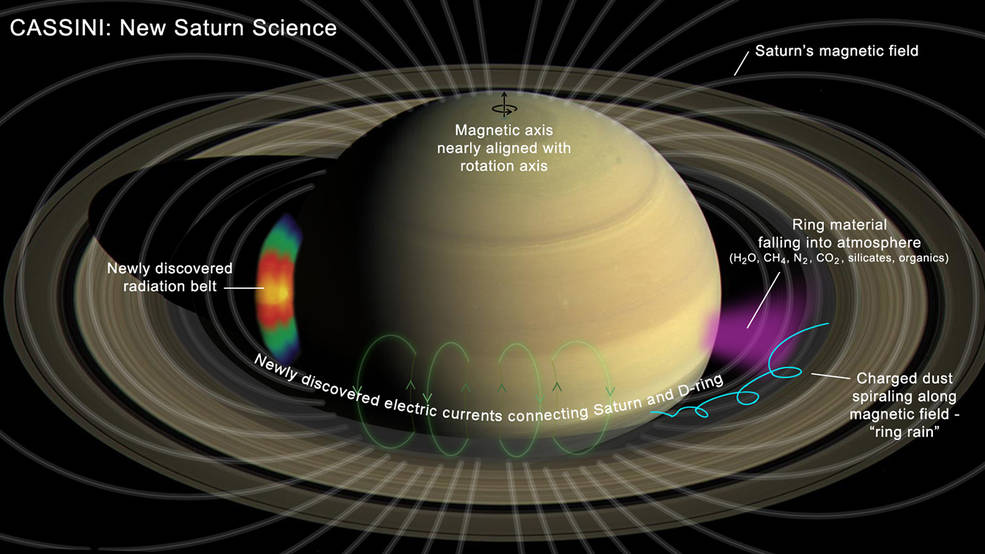
Moreover, Saturn’s highly reflective and easily-visible rings, composed mostly of water-ice and arguably the planet’s most striking feature, are in the process of disappearing. As measured from afar by Earth-based telescopes as well as in situ by the Cassini mission, Saturn is devouring its own rings rapidly through a combination of two related processes: ionized ring rain and dusty/icy equatorial infall.
First, ultraviolet light from the Sun strikes the water-ice rings, as do plasma clouds from meteoroid strikes. These excite the molecules and atoms in the rings, creating ions. Then, Saturn’s electrically charged ionosphere interacts with those ions, funneling them toward high northern and southern latitudes: giving rise to the ring rain.
Meanwhile, as Cassini passed between the rings and the planet, it discovered that the inner ring particles are onfalling onto the planets equatorial region. Combining these two effects — equatorial infall and high-latitude ring rain — allows us to measure the rate of mass loss within the ring system, and constrain the age and lifetime of Saturn’s rings.
They haven’t been around for all 4.5 billion years of the Solar System’s history: rather, they were likely created no more than a scant 100 million years ago, and will be almost completely gone within the next 100 million years.

So where, then, did Saturn’s rings come from? How were they created? Although we are only getting a snapshot of the Saturnian system as it exists today, there are some clues that are encoded in a variety of the surviving objects. By looking at them, we can gain a better context for understanding how and when Saturn’s rings may have arisen.
Clue #1: Mimas
Although there are numerous moons and moonlets located within Saturn’s main rings, Mimas — Saturn’s 7th largest moon overall — is the first moon located outside of the ring system. Mimas is spheroidal despite a mean diameter of only ~400 kilometers, making it the smallest moon in the Solar System to be pulled into a spheroidal shape.
However, Mimas also possesses an enormous impact crater (named Herschel), which itself is approximately one-third of the diameter of the entire moon itself. The impact that formed this crater must have nearly shattered the entire world, as substantial fractures can be found focused on the exact opposite side of Mimas from Herschel itself: at the antipodes. Although Herschel was estimated to have formed approximately 4.1 billion years ago, an indication that Mimas may have been an original moon of Saturn, it’s a stark reminder that worlds can be destroyed entirely by large enough impacts. (Tethys, Saturn’s 5th largest moon, has a similarly large impact crater on it, an indication that Mimas is not unique.)

Clue #2: Enceladus and Saturn’s E-ring
The next major moon of Saturn, moving outward from Mimas, is Enceladus: larger and more massive than Mimas, but also far more active in a puzzling way. Enceladus, despite experiencing much smaller tidal forces from Saturn than Mimas, experiences large eruptions coming from its south pole, where plumes chemically composed of saltwater, sand, ammonia, and organic molecules routinely extend more than 300 kilometers above the icy surface of the world itself. These materials don’t all fall back onto Enceladus, but rather get stretched out to form a diffuse ring made of primarily water-ice coincident with Enceladus’s orbit: Saturn’s E-ring.
Because Enceladus is losing mass so rapidly, and also appears to have a substantial subsurface ocean, an interesting question arises: how old is Enceladus? Was it formed from the primeval Saturnian nebula that created Mimas and many of the other moons? Or did it arise much later, formed out of the debris from the remnants of a previously destroyed satellite?
Enceladus may be relatively young compared to the other large moons orbiting Saturn, with two recent estimates putting Enceladus’s age at ~100 million years and ~1.0 billion years, respectively. It’s a sober reminder that things, as we see them today, may not be a reflection of how they were a relatively short (amount of cosmic) time ago.
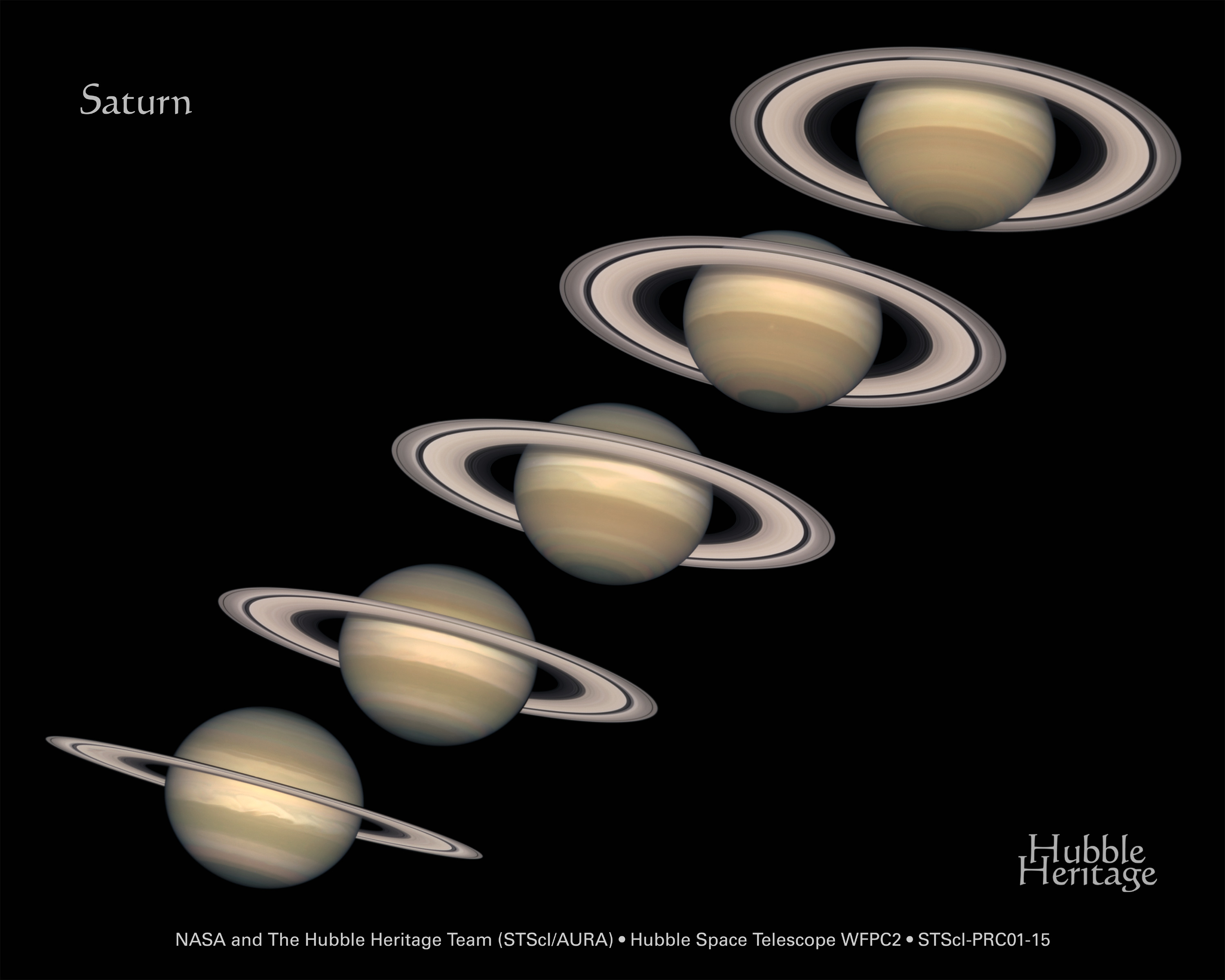
If you were to look at these two clues, you might imagine a very reasonable possibility for the origin of Saturn’s rings: perhaps a previously-existing Moon, orbiting within the inner regions of Saturn, was struck by a large, fast-moving object, and was shattered completely. This material would then re-form into some new Moons — such as (possibly) Enceladus and the innermost ones within the rings — and the rings themselves. This sort of scenario could explain Saturn’s young, ice-rich rings, as well as the bizarre properties of Enceladus, without messing up the properties of the other Saturnian moons.
This explanation hasn’t been ruled out, of course, but there are other properties that it fails to explain. It cannot explain why Saturn has such a large axial tilt, and why all of the moons (interior to Iapetus) as well as the rings have the same tiny orbital inclination with respect to Saturn’s rotation.
In other words, this explanation is plausible, but limited in its explanatory power, while simultaneously possessing the drawback of bringing up new puzzles. Why would such a collision create new rings and new moons in the same plane as all of the old rings and moons? And why is Saturn (and why are its rings and moons) so severely tilted relative to, say, Jupiter and its rings and moons?
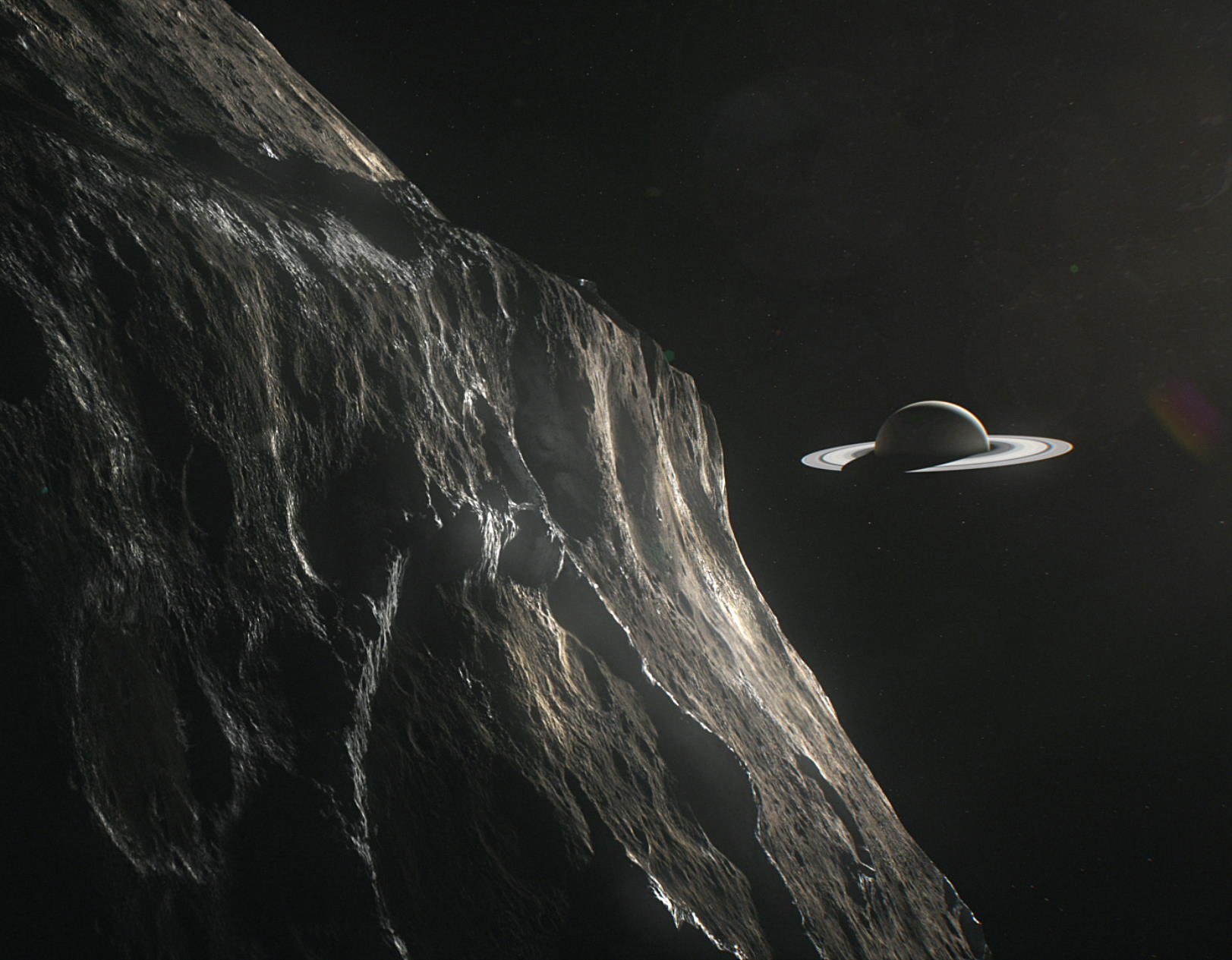
Perhaps this is an indication that there are other clues that we should also be looking at. Here, potentially, is another important and relevant one.
Clue #3: Iapetus
Often noted to be the most bizarre moon in the Solar System, Iapetus has three very rare features that set it apart from most other large moons.
- All of Saturn’s other major moons, including every moon and moonlet located interior to Iapetus, orbit Saturn to within 1.6° of Saturn’s rotational axis. But not Iapetus, which is inclined at 15.5° relative to all of the other Saturnian satellites.
- Iapetus, at its equator, has an enormous equatorial ridge. It spans 1300 kilometers across: nearly the full diameter of the world. The ridge has a width of 20 kilometers and rises to a height of 13 kilometers, following the equator almost perfectly, yet with multiple disconnected segments and isolated peaks.
- And perhaps most strikingly, Iapetus has a two-toned color to it, with one portion covered in darker material and the other, lighter portion covered in ices.
The last such feature is explained by Saturn’s moon Phoebe: itself likely a captured Kuiper belt object. But Iapetus’s inclination and equatorial ridge — which is more continuous on the Saturn-facing side — remain mysterious. Additionally, unlike the innermost 21 moons and moonlets of Neptune, the next three, Titan, Hyperion, and Iapetus, all have larger eccentricities to their orbits, and no one is certain as to why.
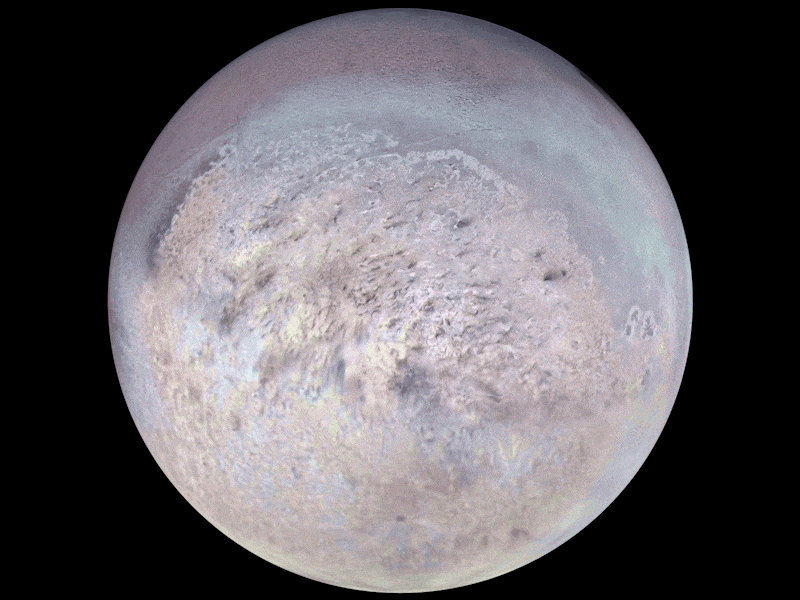
And, finally, there’s one more clue we can look at that holds an important piece of information: the outermost planet in our Solar System. It isn’t just Neptune itself, but rather Neptune’s largest and — if you want to enrage your local planetary astronomer — only moon of note.
Clue #4: Triton
Neptune, if you look at its innermost satellites, has 7 of them that all orbit in practically the same planet that Neptune rotates in. The largest, Proteus, is about the size of Mimas; the most inclined, Naiad, has an orbital inclination of 4.7°. And then, moving outward by one more moon, you encounter Triton: the largest, most massive moon in the Neptunian system by far: nearly 1000 times as massive as Proteus.
Triton is perhaps the poster child for the “one of these things doesn’t belong” game. It:
- orbits at a severe angle to all the other moons,
- in the opposite (retrograde) direction,
- with a composition that makes it similar to Kuiper belt objects, not other Neptunian moons.
Out beyond the orbit of Triton, which orbits Neptune in a little under 6 days, the other Neptunian moons have their orbital periods measured in years, and appear at a wide variety of angles and with large eccentricities. Triton, at some point, came into the Neptunian system, disrupted and/or cleared out the outermore moons, and settled into its current orbit. Only Nereid, and even that has a big “maybe” attached to it, might persist from among Neptune’s outermore original moons, teaching us that large masses can easily “clear out” a planetary system: something that clearly hasn’t happened for the inner ~3.5 million kilometers around Saturn. (Whereas Saturn’s main rings only extend for under ~150,000 km.)

That’s a lot of background, but it all provides the necessary context to understand the latest idea, which puts all of these puzzle pieces together. Instead of the rings, the moons within and interior to them, and Enceladus, there was previously a large, massive moon orbiting between Titan and Iapetus: a body named Chrysalis. Chrysalis would have had to have been comparable in mass to Iapetus, but completing a revolution around Saturn in around 45 days. With an additional mass present in that location:
- Saturn’s moon Titan would have been driven outward,
- leading to increased eccentricities for Titan, Hyperion, and Iapetus, as well as potentially a substantial inclination for Iapetus,
- while Saturn acquires a large axial tilt through a spin-orbit precession resonance with Neptune,
- and Saturn’s hypothetical Chrysalis would have been driven inward by these interactions.
Eventually, Chrysalis would reach the limit of its ability to hold itself together: where tidal gravitational interactions from Saturn and Titan would tear it apart, creating the debris which would eventually re-coalesce into the modern ring system along with an additional of inner moons. According to simulations performed by Wisdom’s team, this fate is one of three that would commonly occur for such a moon, along with ejection and a lunar collision.
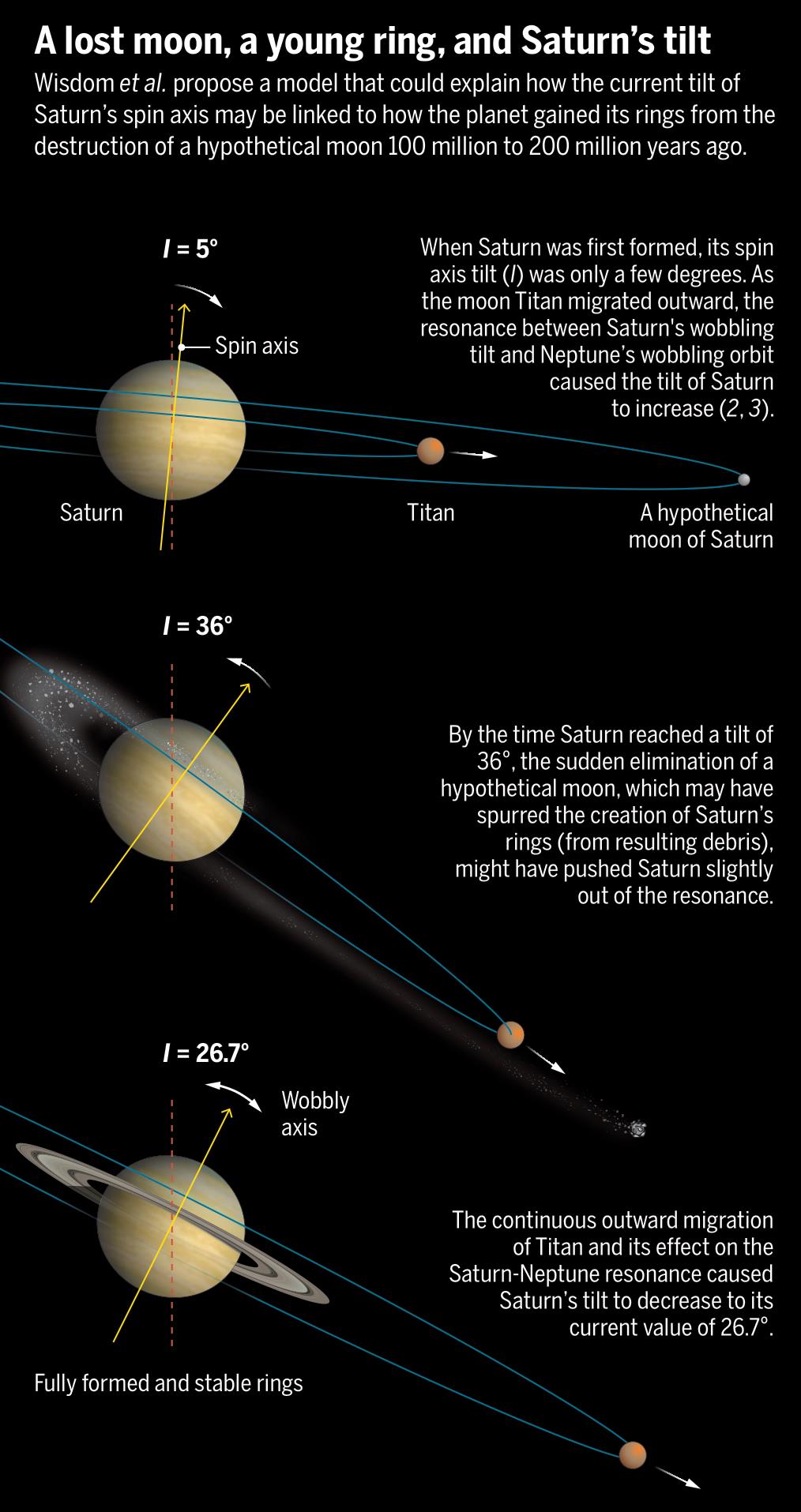
If Chrysalis formed early on in Saturn’s history, it could have driven all of these processes over billions of years, leading to not only the orbital tilt of Saturn, but the relative positions, eccentricities, and obliquities of major moons Titan, Hyperion, and Iapetus. If Chrysalis were then torn apart approximately 160 million years ago, it could have given rise to the inner ring system as well as numerous moons, perhaps including Enceladus — lying substantially outside of the main rings — as well. Additional properties of the Saturnian system that were previously chalked up to coincidence, such as the “gaps” between Rhea and Titan and between Hyperion and Iapetus, could be explained by the presence of this one-time moon as well.
This is a novel and compelling scenario and offers a refreshing alternative to collisions from interplanetary interlopers explaining the destruction of a former Saturnian moon. But the next key step is clear: we must obtain the critical evidence that would support or undermine this theory, determining whether this is truly Saturn’s actual history in the process. By better measuring Saturn’s interior mass distribution and understanding the likelihood of similar events occurring for other (yet to be discovered) ringed planets, we could finally determine with confidence where Saturn’s rings came from and when they formed. Although this kind of planetary detective work is challenging, with the key evidence, we could forensically reconstruct the violent events that led to the currently observed situation. All we need now are the right clues, the missions to uncover them, and a little bit of luck.


